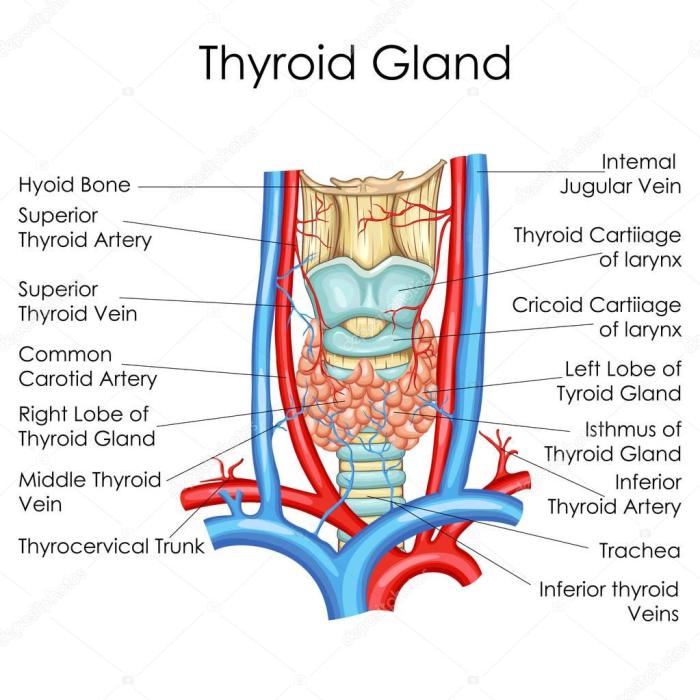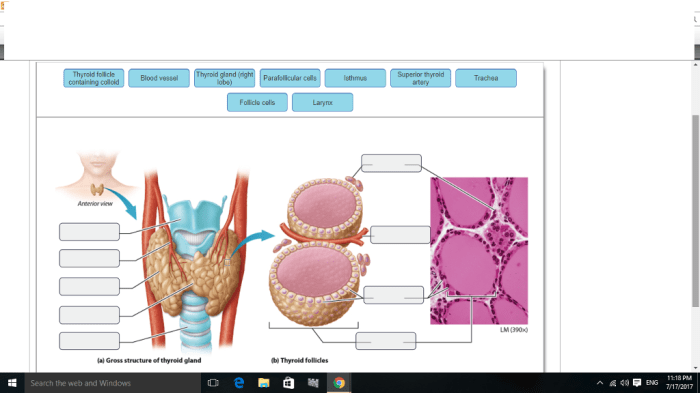Art-labeling activity the structure of the thyroid gland – Embark on an art-labeling expedition into the thyroid gland’s intricate structure, unlocking a comprehensive understanding of this vital endocrine organ. This engaging activity empowers students to visualize and label key anatomical components, fostering a deeper appreciation for the thyroid’s multifaceted functions.
Delve into the thyroid’s strategic location within the neck, its histological makeup, and its pivotal role in hormone production. Trace the intricate steps of thyroid hormone synthesis and secretion, unraveling the mechanisms that regulate these essential processes.
Thyroid Gland Anatomy

The thyroid gland is a small, butterfly-shaped endocrine gland located in the anterior neck, just below the larynx. It consists of two lobes connected by a thin isthmus. Each lobe is about 5 cm long and 2 cm wide, and the isthmus is about 1 cm wide.
The thyroid gland is surrounded by a thin capsule of connective tissue and is closely associated with the parathyroid glands, which are located on its posterior surface.The thyroid gland is composed of follicles, which are small, spherical structures lined by a single layer of cuboidal epithelial cells.
The follicles are filled with a gelatinous substance called colloid, which contains the thyroid hormones thyroxine (T4) and triiodothyronine (T3). The thyroid gland also contains parafollicular cells, which produce the hormone calcitonin.
Thyroid Hormone Synthesis and Secretion: Art-labeling Activity The Structure Of The Thyroid Gland
The thyroid gland plays a crucial role in regulating metabolism by producing and secreting thyroid hormones. The synthesis of thyroid hormones begins with the uptake of iodine from the bloodstream. Iodine is then incorporated into the amino acid tyrosine to form monoiodotyrosine (MIT) and diiodotyrosine (DIT).
MIT and DIT are then coupled to form T4 and T3.The thyroid hormones are stored in the colloid of the thyroid follicles. When stimulated by thyroid-stimulating hormone (TSH) from the pituitary gland, the thyroid gland releases T4 and T3 into the bloodstream.
T4 is the main form of thyroid hormone in the blood, and it is converted to T3 in target tissues. T3 is the biologically active form of thyroid hormone, and it binds to nuclear receptors to regulate gene expression.
Art-Labeling Activity for Thyroid Gland, Art-labeling activity the structure of the thyroid gland
-*Materials
* Diagram of the thyroid gland
Labels for the different structures of the thyroid gland
Instructions:
1. Label the following structures on the diagram of the thyroid gland
Thyroid lobes
Isthmus
Thyroid follicles
Colloid
Parafollicular cells
Thyroid-stimulating hormone (TSH)
Bloodstream
2. Complete the table below with the labeled structures
| Structure | Function ||—|—|| Thyroid lobes | Produce and secrete thyroid hormones || Isthmus | Connects the two thyroid lobes || Thyroid follicles | Store thyroid hormones || Colloid | Contains thyroid hormones || Parafollicular cells | Produce calcitonin || Thyroid-stimulating hormone (TSH) | Stimulates the thyroid gland to release thyroid hormones || Bloodstream | Transports thyroid hormones to target tissues |
Thyroid Gland Disorders

The thyroid gland can be affected by a variety of disorders, including:* Hypothyroidism: A condition in which the thyroid gland does not produce enough thyroid hormones.
Hyperthyroidism
A condition in which the thyroid gland produces too much thyroid hormones.HypothyroidismHypothyroidism is a common disorder, affecting about 5% of the population. It is more common in women than in men, and the risk of developing hypothyroidism increases with age.Symptoms
of hypothyroidism include:* Fatigue
- Weight gain
- Constipation
- Cold intolerance
- Dry skin
- Brittle hair
- Depression
Causes of hypothyroidism include:* Autoimmune disease
- Thyroid surgery
- Radiation therapy
- Medications
HyperthyroidismHyperthyroidism is a less common disorder, affecting about 1% of the population. It is more common in women than in men, and the risk of developing hyperthyroidism increases with age.Symptoms of hyperthyroidism include:* Weight loss
- Increased appetite
- Diarrhea
- Heat intolerance
- Sweating
- Nervousness
- Anxiety
Causes of hyperthyroidism include:* Graves’ disease
- Toxic multinodular goiter
- Thyroiditis
Treatment of Thyroid Disorders

The treatment of thyroid disorders depends on the type of disorder and its severity.HypothyroidismThe treatment of hypothyroidism involves replacing the thyroid hormones that the body is not producing. This is usually done with synthetic thyroid hormones, such as levothyroxine.HyperthyroidismThe treatment of hyperthyroidism involves reducing the production of thyroid hormones.
This can be done with medications, such as methimazole, or with radioactive iodine therapy. In some cases, surgery may be necessary to remove the thyroid gland.
Question Bank
What is the significance of the thyroid gland?
The thyroid gland plays a crucial role in regulating metabolism, growth, and development, influencing a wide range of bodily functions.
How does the art-labeling activity enhance learning?
By actively labeling anatomical structures, students engage multiple senses, promoting retention and comprehension.
What are the common disorders associated with the thyroid gland?
Hypothyroidism and hyperthyroidism are common thyroid disorders, characterized by an underactive or overactive thyroid gland, respectively.